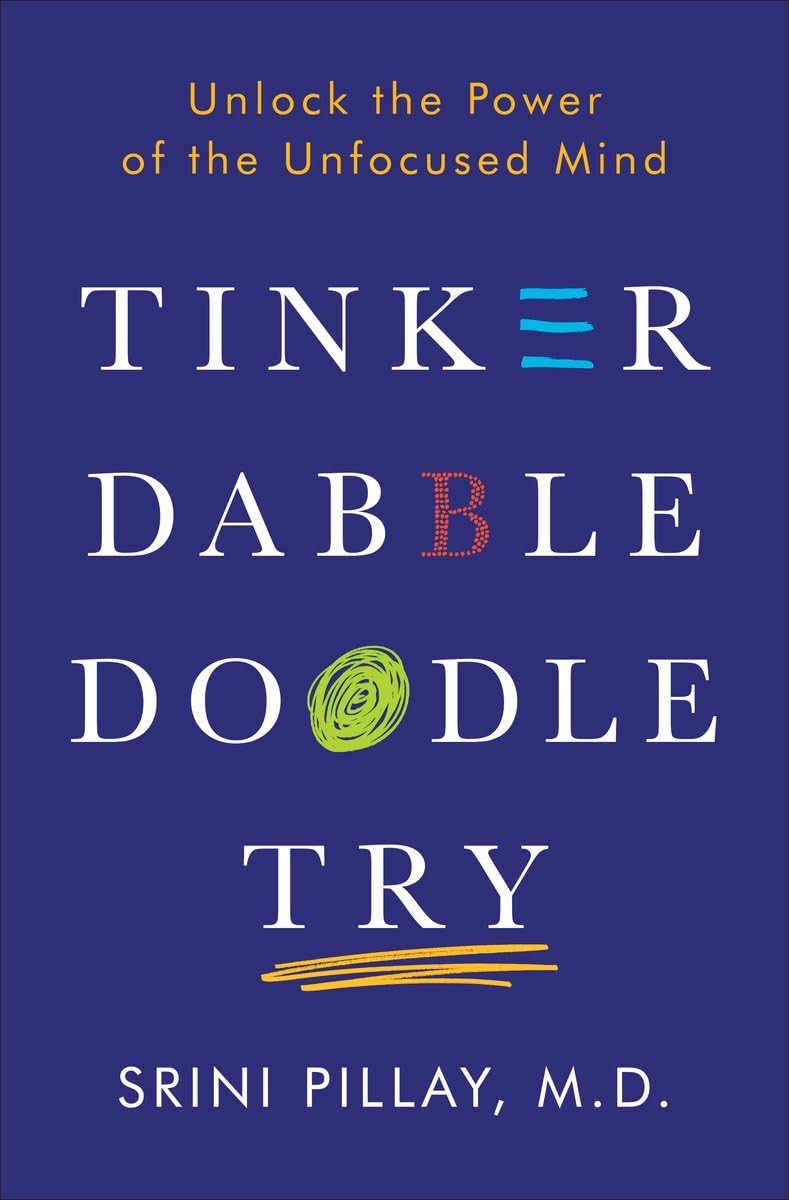Srini Pillay's Tinker Dabble Try: The Power of an Unfocused Mind, a book review

Estimated reading time: 4 minutes
Planned “unfocused” activities can enhance your cognitive toolkit. So says Dr Srini Pillay In “Tinker Dabble Doodle Try: The Power of an Unfocused Mind”. In the book Dr. Pillay challenges the idea that laser-sharp focus is the key to success.
Dr. Srini Pillay’s “Tinker Dabble Doodle Try: The Power of an Unfocused Mind” offers a surprising suggestion how to inculcate problem-solving and innovative thinking skills. Dr. Pillay, a Harvard neuropsychiatrist, challenges the long-held belief that laser-focused concentration is the key to success. Instead, he advocates for deliberately incorporating “unfocused” mental states. By improving at tinkering, dabbling, and doodling, creativity, and problem-solving abilities are improved. So claims the book.
Delivered as an audiobook (the version that I ‘read’), the book translates scientific concepts into digestible morsels of knowledge. This comes at the cost of specific points being less accessible compared to printed format. The book targets individuals experiencing “diffuse focus,” but it’s message aligns with engineers in all situations. That includes those who excel with “narrow focus” and want to expand their cognitive flexibility and ‘breakthrough thinking’. Dr. Pillay differentiates between two types of focus: the concentrated “beam” for execution and the expansive “diffuse” focus for generating outside-the-box ideas.
Dr. Pillay’s core message is clear and immediately relevant to engineers. Planned “unfocused” activities can enhance your cognitive toolkit. He backs his claims with a combination of scientific research, personal anecdotes, and practical exercises. The science is interesting and relevant, though its depth might vary depending on the reader’s prior knowledge of neuroscience. The practical techniques and examples are presented in a clear, relatable manner, making them easily applicable.
As an software engineer, I identified with the book’s core message. Stepping away from problems, exploring unlikely possibilities, and letting go of rigid thinking have helped me reach breakthrough solutions. The book effectively highlights this takeaway: fixation isn’t always the solution. This will go well with those whose job involves solving tricky challenges daily. Folks who encounter ‘aha!’ moments just as they focus away from the problem will strongly identify with the book’s message.
There are significant portions of the book that I didn’t like, however.
Some parts of the book won’t work with a technical audience. The mix of scientific evidence and practical recommendations is great. However it includes topics like tantric sex and unproven brainwaves. That felt out of place and pseudoscientific. This limits the book’s credibility for readers wanting a serious reading.
Additionally, some recommendations in later chapters, were overly optimistic and lacked concrete application.
“Tinker Dabble Doodle Try” makes good points in favor of the power of “unfocused” thinking. It’d be a better book if more pages were dedicated to practical techniques, and omitted irrelevant and non-scientific topics. The book shines when it gets into practical techniques and case studies directly relevant to engineers.
The book focuses on five core areas that I want to explain just a bit more on.
-
Combating Fixation: The book provides tools for recognizing and overcoming “fixation bias”. Techniques like “deliberate breaks,” “unplanned activities,” and “seeking diverse perspectives” can help folks approach problems from new angles and generate fresh ideas. I’ve written extensively on the ‘diverse perspectives’ angle elsewhere on this blog.
-
Enhancing Creativity: The book offers several exercises to stimulate creative thinking, particularly useful for solving complex system problems. Experimenting with new technologies, or engaging in artistic pursuits can create unexpected connections and help reach novel solutions.
-
Boosting Problem-Solving: The book explains how “unfocused” activities can improve problem-solving skills. Techniques like “mind-mapping,” “brainstorming in unusual settings,” and “using metaphors” can help readers break down complex problems. They can identify hidden patterns, and arrive at more elegant solutions.
-
Encouraging Teamwork: The book emphasizes the importance of enabling a culture of “unfocused exploration”. Joint brainstorming sessions, hackathons, and even encouraging team members to pursue personal hobbies unrelated to work can lead to cross-pollination of ideas. I’ve written on the final point here
-
Promoting Adaptability: The book’s message of embracing “unfocused” activities encourages flexible thinking, openness to new ideas, and the ability to adapt to changing circumstances. They are all useful skills for engineers.
I this book a decent 8.5 out of 10 stars. If it had focused less on the less ‘exciting’ aspects of psychology, it’d have gotten a better rating.
